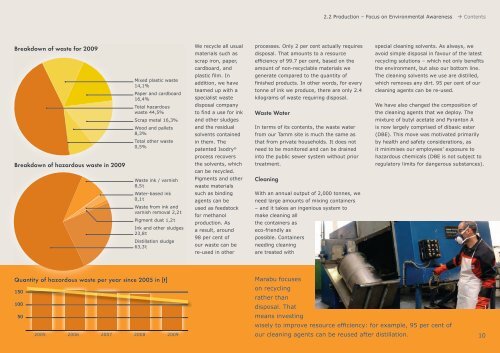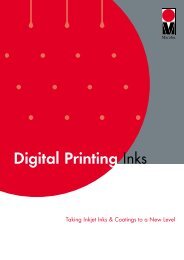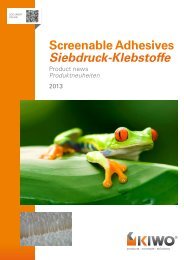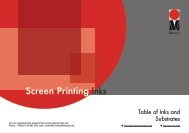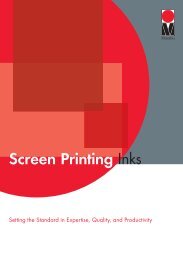Download pdf - Marabu
Download pdf - Marabu
Download pdf - Marabu
Create successful ePaper yourself
Turn your PDF publications into a flip-book with our unique Google optimized e-Paper software.
2.2 Production – Focus on Environmental Awareness Contents<br />
Breakdown of waste for 2009<br />
We recycle all usual<br />
materials such as<br />
processes. Only 2 per cent actually requires<br />
disposal. That amounts to a resource<br />
special cleaning solvents. As always, we<br />
avoid simple disposal in favour of the latest<br />
scrap iron, paper,<br />
efficiency of 99.7 per cent, based on the<br />
recycling solutions – which not only benefits<br />
cardboard, and<br />
amount of non-recyclable materials we<br />
the environment, but also our bottom line.<br />
Mixed plastic waste<br />
14,1%<br />
Paper and cardboard<br />
16,4%<br />
Total hazardous<br />
waste 44,5%<br />
Scrap metal 16,3%<br />
Wood and pallets<br />
8,3%<br />
Total other waste<br />
0,5%<br />
plastic film. In<br />
addition, we have<br />
teamed up with a<br />
specialist waste<br />
disposal company<br />
to find a use for ink<br />
and other sludges<br />
and the residual<br />
solvents contained<br />
in them. The<br />
patented Isodry ®<br />
generate compared to the quantity of<br />
finished products. In other words, for every<br />
tonne of ink we produce, there are only 2.4<br />
kilograms of waste requiring disposal.<br />
Waste Water<br />
In terms of its contents, the waste water<br />
from our Tamm site is much the same as<br />
that from private households. It does not<br />
need to be monitored and can be drained<br />
The cleaning solvents we use are distilled,<br />
which removes any dirt. 95 per cent of our<br />
cleaning agents can be re-used.<br />
We have also changed the composition of<br />
the cleaning agents that we deploy. The<br />
mixture of butyl acetate and Pyranton A<br />
is now largely comprised of dibasic ester<br />
(DBE). This move was motivated primarily<br />
by health and safety considerations, as<br />
it minimises our employees’ exposure to<br />
process recovers<br />
into the public sewer system without prior<br />
hazardous chemicals (DBE is not subject to<br />
Breakdown of hazardous waste in 2009<br />
the solvents, which<br />
can be recycled.<br />
treatment.<br />
regulatory limits for dangerous substances).<br />
Waste ink / varnish<br />
8,5 t<br />
Pigments and other<br />
waste materials<br />
Cleaning<br />
Water-based ink<br />
0,1 t<br />
Waste from ink and<br />
varnish removal 2,2 t<br />
Pigment dust 1,2 t<br />
Ink and other sludges<br />
23,8 t<br />
Distillation sludge<br />
63,3 t<br />
such as binding<br />
agents can be<br />
used as feedstock<br />
for methanol<br />
production. As<br />
a result, around<br />
98 per cent of<br />
our waste can be<br />
re-used in other<br />
With an annual output of 2,000 tonnes, we<br />
need large amounts of mixing containers<br />
– and it takes an ingenious system to<br />
make cleaning all<br />
the containers as<br />
eco-friendly as<br />
possible. Containers<br />
needing cleaning<br />
are treated with<br />
Quantity of hazardous waste per year since 2005 in [t]<br />
150<br />
100<br />
50<br />
2005 2006 2007 2008 2009<br />
<strong>Marabu</strong> focuses<br />
on recycling<br />
rather than<br />
disposal. That<br />
means investing<br />
wisely to improve resource efficiency: for example, 95 per cent of<br />
our cleaning agents can be reused after distillation.<br />
10


